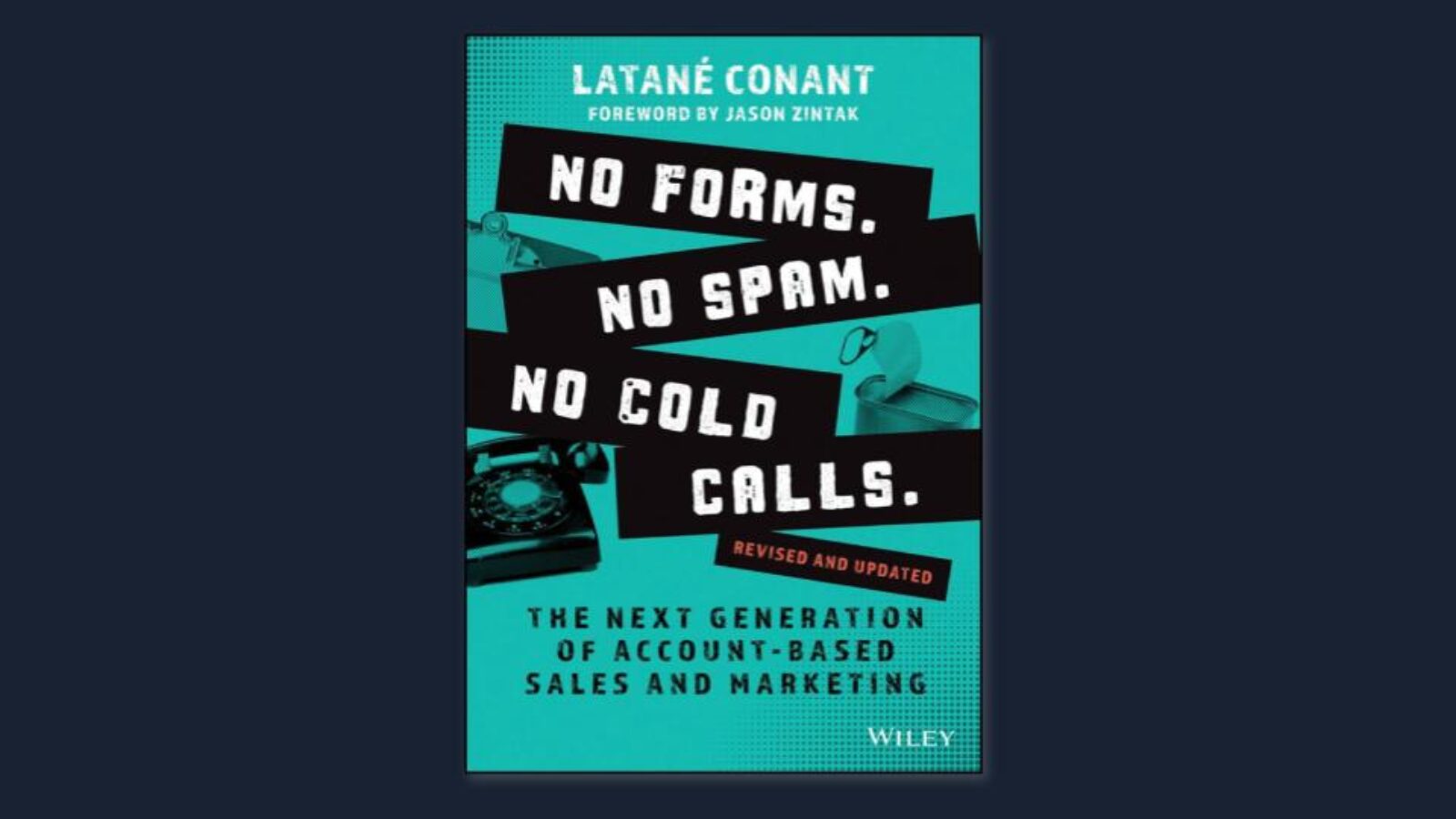When it was published two years ago, 6sense CMO Latané Conant’s knockout book on modern ABM and revenue operations — No Forms. No Spam. No Cold Calls. — shook up the revenue landscape. It armed revenue teams with a revolutionary way to connect with customers.
The recently released expanded second edition from Wiley features even more thought leadership, including ways to unlock the full potential of your sales team.
A New Chapter, Written by 6sense’s SVP of Global Sales

To deepen the perspective across the revenue team, Conant invited 6sense SVP of Global Sales Mark Ebert to contribute a chapter about how sales leaders can use modern practices to help their teams produce predictable growth and high-quality pipeline.
Ebert shares the secrets of his own successful team that are also used by our customers:
- Using data and technology to increase efficiency and power growth
- Diving into the Dark Funnel to uncover hidden account intelligence (and hidden accounts!)
- Setting reps up to win with new strategies, support, and solid tech-backed information
- Shifting to an account-based strategy to reclaim time and power deal flow
- Coordinating with marketing and enablement to fuel growth
- And more
To provide a deeper look into what these revenue dynamos have to share, we’re presenting an excerpt from this brand-new chapter touching on two key concerns sales leaders face today: Hiring and Retention and Alignment Across the Revenue Team.
Get Your Copy of ‘No Forms. No Spam. No Cold Calls.’
Excerpt 1: Hiring and Retention
Everything we’ve talked about so far in this chapter is about putting reps in the position to have repeatable success with less effort. All the tools we’re giving them shorten the distance between them and their commission check or an invitation to Club.
Those are things that make for happy, enthusiastic, and loyal sellers. And that makes the job of hiring and retaining top talent much easier. Especially these days, when the job market is tighter than I’ve ever seen it, the best sellers have their choice of places to work. If we can’t prove to them that we’ll put them in the best position to win, they’ll go elsewhere. It’s that simple.
If, on the other hand, we can show that we give our sellers the technology, tools, and support they need to prioritize their time and start making good money fast, we have a leg up on the competition when it comes to hiring and retention.
As managers, the insights we use for territory planning also give us the confidence to hire the right number of people to work the right segments and territories. We know the exact number of accounts that are in-market at any given time, meaning we can know with certainty how many new sellers we can support when we’re getting ready to hire.
For the sellers we’re recruiting, that message really resonates. We’re able to tell recruits, “I can get you ramped and winning faster than the other companies you’re considering. Here are our sales numbers and attainment rates, and here’s why I know the territory I’m giving you will net you that same level of success.” Knowing that they can start hitting and exceeding their quota fast is a huge motivator for sellers, and it helps us immensely in the recruiting process.
We decided to start a commercial team from the ground up a few years ago, when we were still pretty small. Without access to the information we had available, we might have started small and tested the waters by hiring one or two reps. But our technology showed us that we had a surprising number of commercial accounts visiting our site and not raising their hands — probably because we didn’t have product pricing or packaging to accommodate them.
We dug further into our in-market data and found that not only was there huge potential here, but our competitors weren’t serving that market. So we jumped in with both feet. Our revenue team worked together to make sure we could onboard and support the commercial segment and make them successful in a cost-efficient way — and then we poured gas on the fire. We promoted one of our enterprise account executives, Mac Conn, to head up a new team, and he hired six new reps to break into the commercial segment.
Was it risky? Well no, not really. We had the data in front of us to show us that as soon as we turned on this tap, we’d have enough accounts to keep all of our new reps fed. And we did — even as Covid hit just weeks after they came on board.
At a time when many sales teams were struggling with how and whether to reach out to people, we could use our technology to see who was still in-market and actively researching. So they were able to reach out without being insensitive — and in fact, they found they were providing a crucial service at a critical time. By having a direct line of sight into which commercial accounts were searching for ways to make up for lost pipeline, our brand new team was able to continue smashing attainment goals, even in the midst of a once-in-a-lifetime economic upheaval.
What this experience showed me is that whether we’re operating in a business-as-usual environment or breaking into new markets in the midst of a pandemic, we can be confident in our ability to make our reps successful as long as we’re making data-driven decisions. And that’s the secret to hiring and keeping the best sales talent around.
Get Your Copy of ‘No Forms. No Spam. No Cold Calls.’
Excerpt 2: Alignment Across the Revenue Team
The approach laid out in this chapter has countless benefits, both tangible and intangible. But the most significant change that comes from this modern sales leadership philosophy is true alignment — across the sales team, yes, but also across the entire revenue team.
It’s no secret that alignment between sales and marketing is something between an aspiration and a pipedream at many organizations. That’s a huge problem, because when revenue teams are not aligned, they inevitably (and quickly) hit a ceiling in terms of what they can accomplish. Without true alignment, strategy suffers. Revenue suffers. The whole company suffers.
So if alignment is so important, why is it so elusive? A big reason is that sales teams don’t trust the leads that marketing provides. And that’s with good reason — as Latané explained in previous chapters, marketing-qualified leads are often useless — they’re either arbitrarily scored and not actually based on real signals of interest or intent, or they come to the sales team so late that even if we act on them right away, we’re too late to get into the deal.
Our sellers know this. They see that MQLs don’t convert, and so they start to ignore them. That frustrates marketers, who begin to feel like their efforts are wasted. And from their perspective, it looks as if sales is just being lazy and not working leads the way they should.
A cycle of distrust and division is born.
Another issue is that at the highest levels, CROs and CMOs can’t agree on goals, metrics of success, or even which data to use to inform decision-making. This is a major impediment to success, since research shows the most important thing successful high-growth companies do is to get aligned on things like total addressable market, ideal customer profile, and so forth.
These walls between the different parts of the revenue team are real, but modern technology is starting to break them down. Part of the change we’re seeing in tech is that there’s more of it and it’s better than it used to be. But another way tech is changing is that much of it serves the entire revenue organization. Data that used to flow to Marketing Operations or Sales Operations — and, more often than not, stop there — can now flow throughout the marketing, sales, and customer success teams. And thanks to AI, the same data can be turned into insights and action steps that are uniquely useful to people in different roles.
Revenue technology allows us to leave behind the MQL hand-off that has plagued marketing and sales teams. Instead, it offers a way for the entire revenue team to prioritize the best accounts to pursue, gain deep insights into those accounts, and work jointly to move those accounts through the buying journey. This is possible because of objective and trustworthy data that shows what our buyers are doing, what they care about, and where they are in the buying journey.
That’s a big step up from the arbitrary guesswork and lead scoring that has caused so many headaches in the past.
With this single source of truth, we can focus on the metrics that matter. In other words, not marketing-qualified leads. Instead, we want to work with our marketing counterparts to focus on metrics like conversion rates, deal size, overall qualified pipeline, win rates, and revenue.
Aligned revenue technology enables us to share a common set of metrics. And that leads to continuous conversation and collaboration between the departments on things like:
- Ideal customer profiles
- Go-to-market motions
- Segmentation
- Account prioritization
- Account nurturing
- Pipeline planning
As a sales leader, your collaboration with the CMO is critical for all of these areas. Here is what has worked well for Latané and me:
Collaboration around territory planning. When spinning up a new territory, Latane and I look at data to determine best places to add AEs based on previous success and business objectives.
Consider the pod needed to support a territory. We also make sure that Latané has the team and resources to support this new territory so the AEs are set up to be successful. We’ve always thought about this in terms of pre-sales, but the pod also needs marketers — an ABX marketer, as well as MDRs and/or BDRs.
Use segmentation to inform ABX strategy. By creating segments and looking at their behaviors and interests, we can work together to inform our go-to-market strategies for those segments. For instance, when running a competitive takeout for big strategic accounts, we set up a segment to include the top 20 strategic accounts we wanted to book meetings with, and then monitored their activity. Were they looking at us or our competitors? What keywords and topics were they interested in? Then sales and marketing worked together to use that data and create an account-based experience that would most effectively engage these high-stakes prospects. This strategy is also very useful for renewal and retention.
Work together on pipeline targets. Latané and I work backward from the bookings number by segment to create our pipeline targets. It doesn’t matter if it’s sales-sourced or marketing-sourced, we just want to feed the AEs. What does matter is the assumptions and how those are trending. We look at each segment every quarter and use the underlying trends to create targets for the next quarter.
Account for seasonality. Historical data shows us when we can expect to see seasonal slowdowns, so we account for those in advance by working together to plan sales and marketing spiffs. For instance, we did a spiff over the summer to get us set up with enough pipeline in Q4.
Aligning our teams. Latané and I make sure our teams are working together with the same level of collaboration she and I are committed to. We have a monthly all-revenue team call, and in our sales meetings, the ABX team is aligned to an RVP. I also make sure to hold AEs and managers accountable for holding up their end of the collaboration.
Hold ourselves accountable. We all need to be stewards of the pipeline, and each AE and manager needs to be accountable for their book of business. The best sellers think of themselves as entrepreneurs. They take advantage of everything marketing offers to help them hit their goals. But at the end of the day, they understand that it’s their responsibility to hit their numbers — no one else’s. As CRO, it’s important to model this spirit of accountability and support for marketing’s efforts and expertise.
To get accounts to the point where they’re ready to cross the finish line and produce predictable revenue growth, it’s essential that the entire revenue team be on the same page. And revenue technology makes that possible in ways that it never has been before.
In my experience and in our research, this collaborative approach creates a flywheel effect. As the revenue team starts to align on metrics that matter and implement a coordinated, data-based, AI-supported strategy, they start to see wins, fast. And as those early wins accumulate, trust improves. Sales and marketing teams see that their collaboration is working, and so it happens more. We develop the kind of high-level trust and collaboration across the entire revenue team that’s necessary to deliver long-term, predictable revenue growth.
Get Your Copy of ‘No Forms. No Spam. No Cold Calls.’
Conclusion
Love it? There’s more. This is just a fraction of the solid content in Ebert’s chapter — relevant, actionable, and fresh — and the entire book.
So many marketing and revenue team members have shared how the original book changed the entire way they approach the sales funnel, and how those shifts have blown their pipeline predictions and metrics out of the water.
Ready to join them and take your revenue team into the modern age? The new edition of No Forms. No Spam. No Cold Calls is here.






